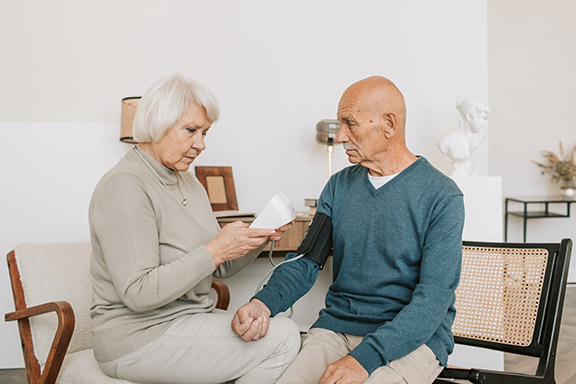 Blood pressure monitoring and control is an important aspect of slowing the progression of kidney disease and protecting the heart. Blood pressure taken at home is more reliable than blood pressure checked in the doctor’s office. A recent study done among kidney care clinic patients and health-care providers reveals barriers – and also useful and practical ways to better support patients – in monitoring blood pressure at home.
Blood pressure monitoring and control is an important aspect of slowing the progression of kidney disease and protecting the heart. Blood pressure taken at home is more reliable than blood pressure checked in the doctor’s office. A recent study done among kidney care clinic patients and health-care providers reveals barriers – and also useful and practical ways to better support patients – in monitoring blood pressure at home.
“We know that blood pressure monitoring and control is something patients can actively do to help control their underlying illness,” explains Dr. Megan Borkum, a clinical and research fellow with BC Renal and the University of British Columbia’s Division of Nephrology who was involved in the study. “And it gives them some power over their health.”
Borkum also notes that when patients receive blood pressure measurements in the doctor’s office, these readings may be abnormally high due to the stress some patients feel from being in a clinic. Home blood pressure monitoring can offer more accurate and consistent measurements.
Borkum’s team sought to better understand the perceived barriers that interfere with people living with kidney disease in completing blood pressure monitoring at home. They surveyed 46 patients and 43 staff from 16 kidney care clinics across BC.
The results show gaps between the practices and beliefs of patients and staff on home blood pressure monitoring and that there’s a need to standardize how staff support patients. For example, 18% of patients didn’t know their ideal individual blood pressure targets and only 39% of patients had received a blood pressure target from their kidney care clinic team. What’s more, only 54% of patients knew what to do when their blood pressure was off-target.
This prompted the research team, which included several patient partners, to create tools to support patients in completing home blood pressure monitoring.
“In partnership with the patient partners, we compiled a clear, one-page guide for patients, which they can hang on their wall and have next to the blood pressure machine, to remind them to measure their blood pressure and explain the exact steps on how to do it correctly,” says Borkum.
The study also showed ways in which health-care providers can better support home blood pressure monitoring, for example by educating patients on the importance of blood pressure, providing individualized targets, and helping patients to measure their cuff size.
“As someone who works at a kidney care clinic, I can certainly see there’s a lot more awareness after this study around correct blood pressure monitoring, target setting and the new resources we’ve created,” says Borkum.
“In the future, I think it would be beneficial to implement a similar intervention with perhaps the peritoneal dialysis and transplant patients because they struggle with high blood pressure as well, often as a result of a lot of the medications they take,” she says. “So there are lots of ways to expand upon this project.”
Publication: The Patient-Provider Gap: A Cross-sectional Survey to Understand Barriers and Motivating Factors for Home Blood Pressure Monitoring in a CKD Cohort PATIENT RESOURCES: Kidney Care (Non-dialysis) On this page, click on the
Resources for Kidney Patients tab, and then see the
Taking Your Blood Pressure at Home section.
HEALTH PROFESSIONAL RESOURCES:
Chronic Kidney Disease (CKD) On this page, click on the
Kidney Care Clinic Guidelines tab, and then see the
Home Blood Pressure Monitoring section.

